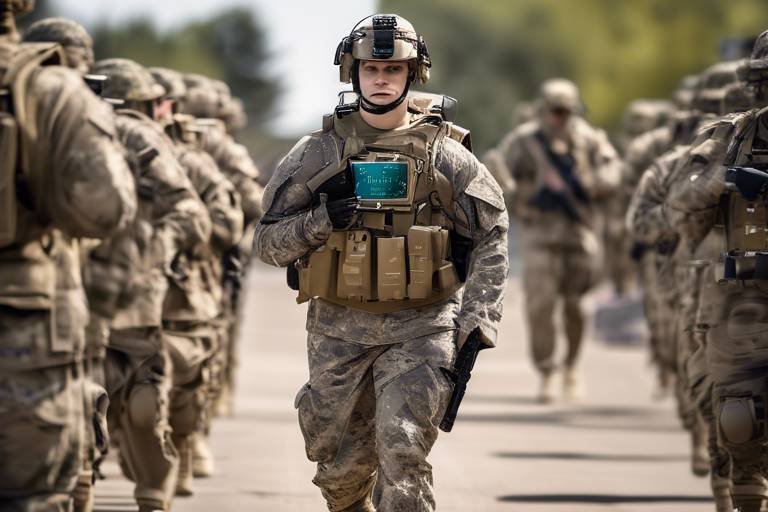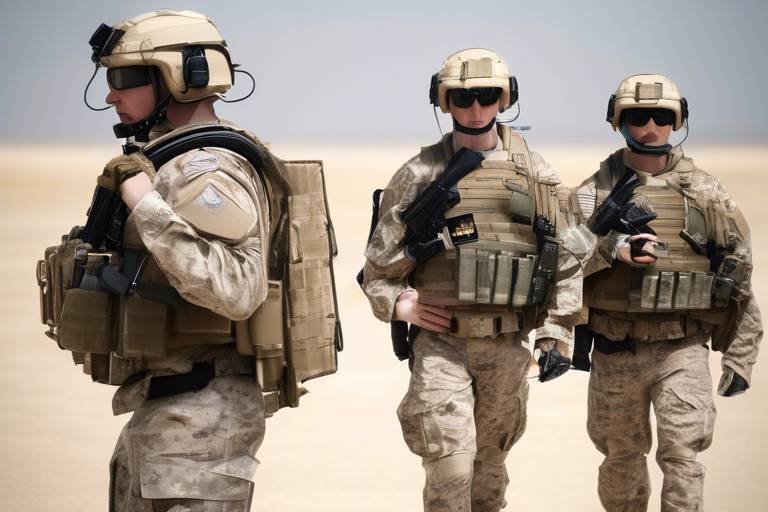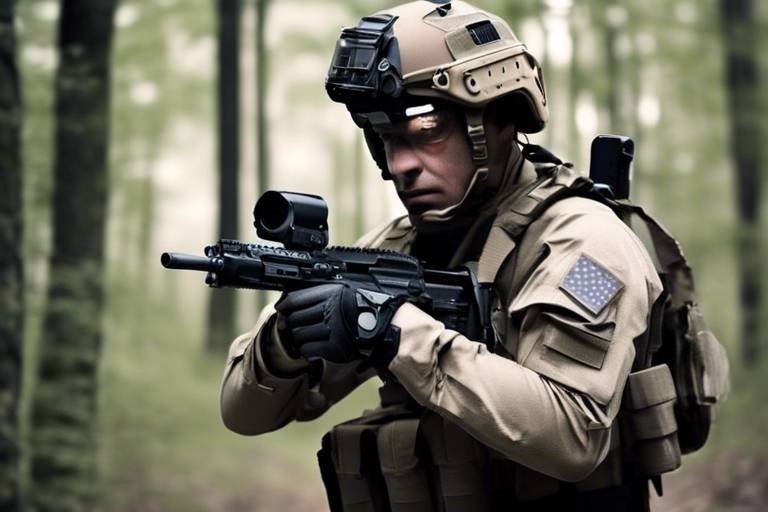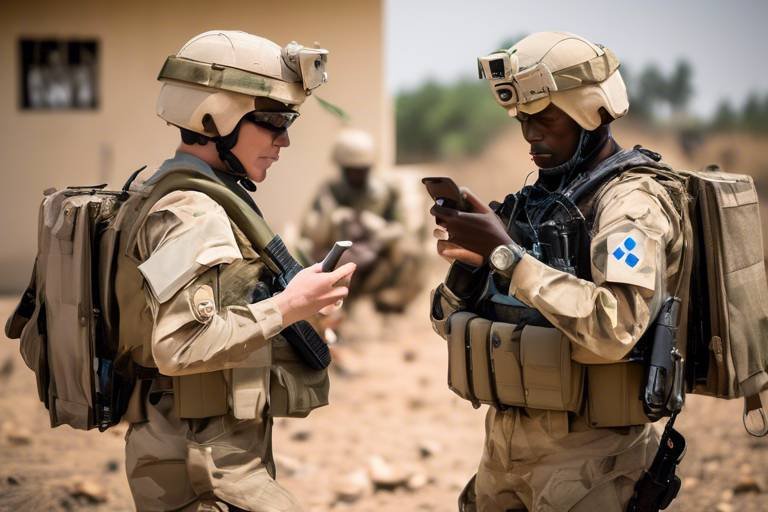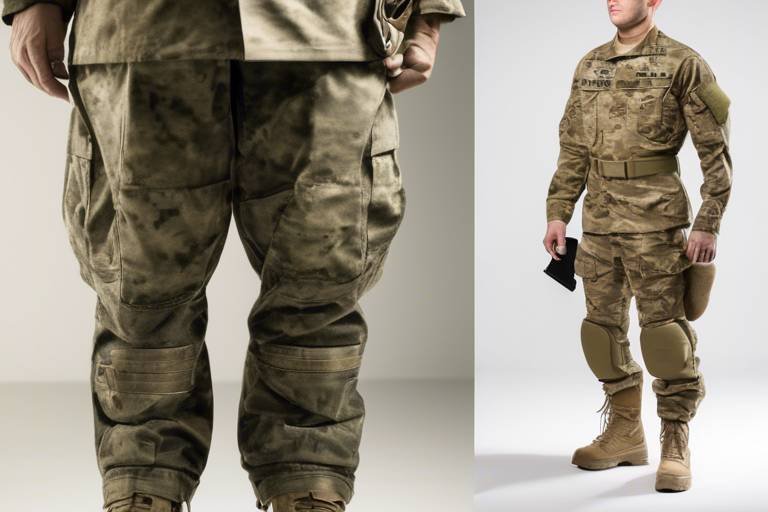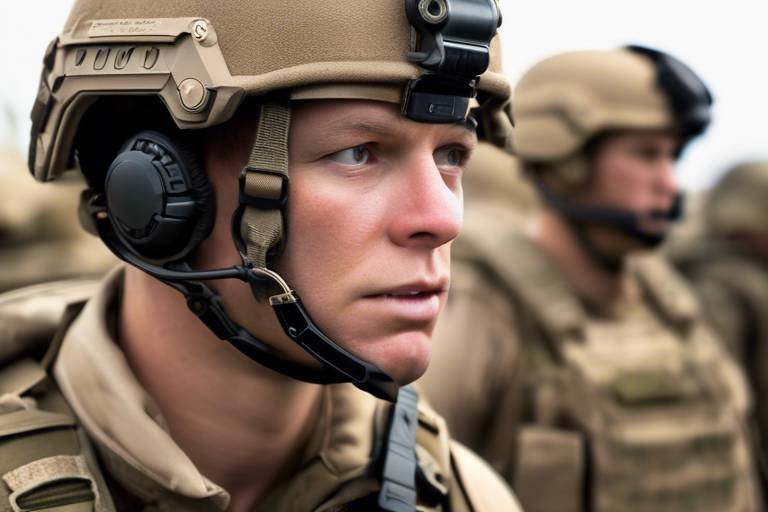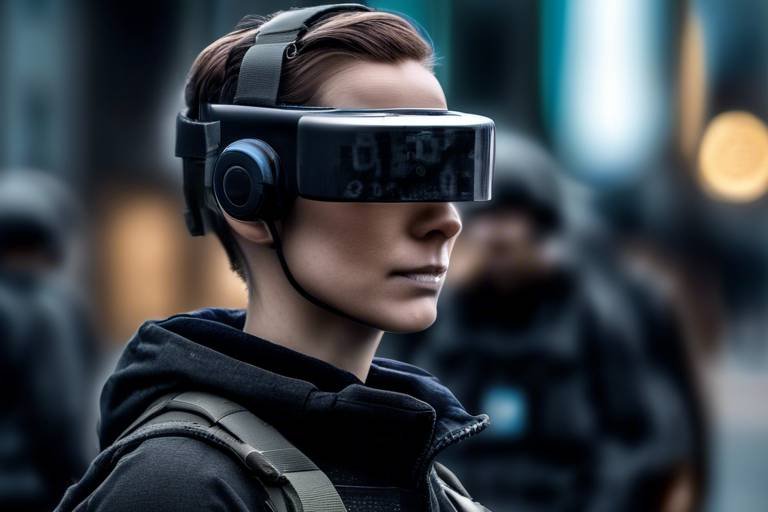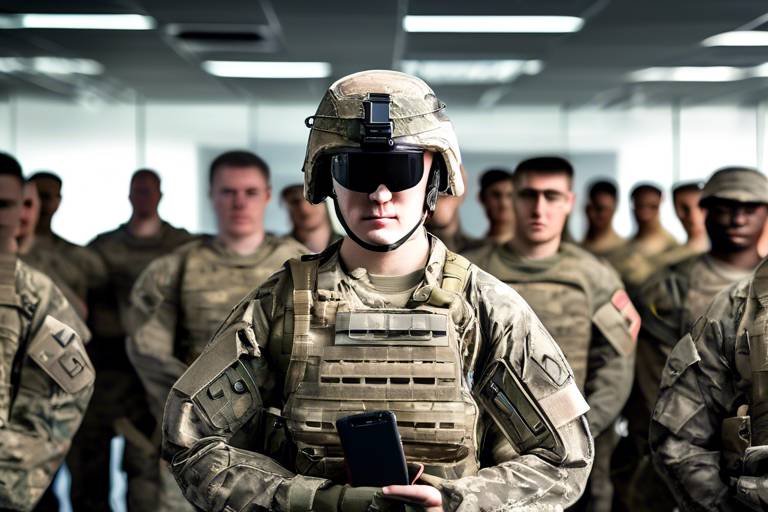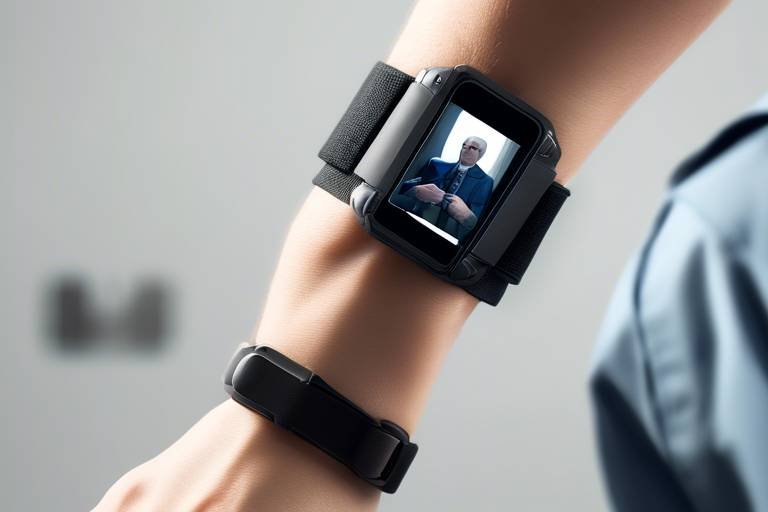The Integration of AI into Military Wearable Technologies
The world of military technology is undergoing a seismic shift, thanks to the integration of artificial intelligence (AI) into wearable devices. Imagine soldiers equipped with smart gear that not only tracks their movements but also anticipates their needs, analyzes data in real-time, and enhances their decision-making capabilities. This transformation is not just about upgrading existing tools; it's about redefining how military operations are conducted. AI-powered wearables are becoming the backbone of modern warfare, providing a competitive edge that can be the difference between victory and defeat.
As we delve deeper into this topic, we will explore the various advancements in AI algorithms that have propelled military wearables into a new era. These technologies are designed to support soldiers in the field, ensuring they have access to crucial information when it matters most. The battlefield is a chaotic environment, and the ability to process vast amounts of data rapidly can significantly enhance operational effectiveness. With AI, military wearables can analyze environmental factors, predict potential threats, and deliver insights that allow soldiers to make informed decisions swiftly.
Moreover, the implications of these advancements extend beyond mere functionality. They raise important questions about the future of warfare, the ethical considerations of using AI in combat, and the potential for enhanced soldier safety and health monitoring. As we navigate through this rapidly evolving landscape, it’s essential to understand not only the benefits but also the challenges that come with integrating AI into military wearable technologies.
In this article, we will cover:
- Advancements in AI Algorithms
- Enhanced Situational Awareness
- Health Monitoring Capabilities
- Ethical Considerations
- Future Trends in Military Wearables
So, buckle up as we embark on this journey to uncover how AI is revolutionizing military wearables and what that means for the soldiers who rely on these technologies in the field.
- What are military wearables?
- Military wearables are advanced devices worn by soldiers that can track various metrics such as health data, location, and environmental conditions, often enhanced by AI technology.
- How does AI improve military wearables?
- AI enhances military wearables by enabling real-time data analysis, predictive capabilities, and improved situational awareness, allowing soldiers to make better decisions in the field.
- What ethical concerns are associated with AI in military wearables?
- Ethical concerns include data privacy issues, the potential for autonomous decision-making in combat, and the implications of relying on AI for critical military decisions.
Advancements in AI Algorithms
Recent developments in AI algorithms have revolutionized the functionality of military wearables, resulting in a paradigm shift in how soldiers interact with technology on the battlefield. Imagine a world where decisions are made faster than the blink of an eye, where data is processed in real-time, and where soldiers are equipped with tools that enhance their cognitive capabilities. This isn't science fiction; it's the reality of today's military landscape. With advancements in machine learning and neural networks, military wearables are now capable of analyzing vast amounts of data instantaneously, providing soldiers with critical insights that can mean the difference between life and death.
One of the key breakthroughs in this area is the ability of AI algorithms to learn from experience. Just as humans adapt based on past encounters, these systems continuously improve their predictive capabilities. For instance, when a soldier wears a device that monitors environmental conditions, the AI can recognize patterns in the data that indicate potential threats, such as changes in temperature or unusual movements nearby. This predictive power enables soldiers to stay one step ahead of adversaries, enhancing their operational effectiveness.
Moreover, the integration of real-time data processing into military wearables has transformed decision-making processes. Soldiers can now receive immediate feedback based on their actions, allowing for quicker adjustments to strategies. For example, if a soldier receives a notification about an unexpected enemy movement, the AI can analyze the situation and suggest optimal responses based on historical data and current battlefield dynamics. This level of responsiveness is unprecedented and significantly enhances the soldier's situational awareness.
Furthermore, the implementation of data fusion techniques plays a crucial role in the advancement of AI algorithms. By combining information from various sensors—such as GPS, thermal imaging, and biometric data—military wearables create a comprehensive understanding of the battlefield. This holistic view allows commanders to make informed decisions based on a multitude of factors, improving their strategic planning and execution. For instance, a soldier's wearable device might integrate data from drones overhead, providing real-time updates on enemy locations while simultaneously monitoring the soldier's vital signs.
In summary, the advancements in AI algorithms are not just enhancing military wearables; they are fundamentally changing the way soldiers operate in the field. With improved data processing, predictive capabilities, and data fusion techniques, these technologies empower soldiers to make informed decisions swiftly and efficiently. As we look to the future, the potential for further innovations in AI will only deepen the integration of technology into military operations, making the battlefield a more intelligent and responsive environment.
Enhanced Situational Awareness
This article explores the transformative impact of artificial intelligence on military wearable technologies, highlighting advancements, applications, and implications for soldiers in the field.
Recent developments in AI algorithms have significantly enhanced the functionality of military wearables, enabling real-time data processing and decision-making support for soldiers during missions.
In the chaotic environment of the battlefield, situational awareness is paramount. AI-powered wearables have revolutionized how soldiers perceive their surroundings, providing them with a heightened sense of awareness that can mean the difference between life and death. Imagine being in a dense forest, where every rustle of leaves could signify a hidden threat. With AI technology integrated into their gear, soldiers can receive real-time updates about their environment, such as identifying potential ambush points or detecting movement in the underbrush.
These wearables analyze a plethora of data from various sources, including GPS, cameras, and environmental sensors, to create a comprehensive view of the battlefield. By utilizing data fusion techniques, military wearables can synthesize information from multiple sensors, enabling soldiers to make informed decisions quickly. For example, if a soldier is patrolling an area and the AI detects unusual patterns or movements, it can alert them instantly, allowing for a proactive response rather than a reactive one.
Data fusion is the backbone of enhanced situational awareness. By combining inputs from various sensors, these systems create a unified picture of the operational environment. This is akin to putting together a jigsaw puzzle; each piece of data contributes to a clearer understanding of the whole scene. For instance, if a soldier is equipped with a wearable device that integrates thermal imaging with traditional visual data, they could identify hidden threats that would otherwise remain invisible.
The integration of multiple sensors into wearable technologies allows for the collection of diverse data types. This includes everything from biometric readings to environmental conditions. The AI processes this data to enhance mission outcomes by predicting potential hazards and optimizing routes. Think of it as having a personal assistant who not only knows your schedule but also the best times to avoid traffic or hazards on your way to a meeting.
Real-time analytics powered by AI facilitate quick decision-making, allowing soldiers to respond effectively to dynamic situations on the battlefield. This capability is crucial, as conditions can change in the blink of an eye. For example, if a soldier encounters unexpected enemy fire, the AI can analyze the situation and suggest immediate tactical responses based on the current battlefield dynamics. This level of responsiveness is essential for maintaining an advantage in combat.
Machine learning applications in military wearables enhance predictive capabilities, enabling soldiers to anticipate enemy movements and optimize resource allocation. By analyzing historical data and current trends, the AI can provide insights that help soldiers prepare for various scenarios. This predictive nature not only improves tactical planning but also increases the overall safety of the troops.
AI-driven health monitoring systems in military wearables track vital signs and physical conditions, ensuring soldiers' well-being and readiness during operations.
Advanced algorithms can analyze physiological data to detect stress and fatigue levels, allowing commanders to make informed decisions about troop deployment.
Wearable technologies equipped with AI can provide insights into injury risks, helping to implement preventive measures and enhance soldier safety.
The integration of AI into military wearables raises ethical questions regarding privacy, data security, and the implications of autonomous decision-making in combat scenarios.
Ensuring the privacy of soldiers' personal data is critical as military wearables collect sensitive information about their health and performance.
The use of AI in decision-making processes prompts discussions about accountability and the moral implications of autonomous systems in warfare.
The future of military wearables will likely see further advancements in AI, leading to more sophisticated technologies that enhance soldier effectiveness and safety on the battlefield.
Future wearables may integrate with drones and autonomous vehicles, creating a cohesive network that enhances operational capabilities and situational awareness.
AI will enable military wearables to adapt to individual soldier needs, providing tailored support and improving overall mission performance.
- How does AI improve situational awareness for soldiers?
AI enhances situational awareness by processing data from various sensors, providing real-time updates and alerts about potential threats in the environment. - What role do data fusion techniques play in military wearables?
Data fusion techniques combine information from multiple sources to create a comprehensive understanding of the battlefield, aiding in decision-making. - Can AI in wearables help prevent injuries?
Yes, AI can analyze physiological data to identify stress and fatigue levels, allowing for better monitoring of soldiers' health and implementing preventive measures.
Data Fusion Techniques
In the rapidly evolving landscape of military technology, have emerged as a game-changer for enhancing the effectiveness of military wearables. These techniques enable the integration of data from various sources, such as sensors and intelligence feeds, to create a holistic view of the battlefield. Imagine a puzzle where each piece represents a different aspect of the environment—weather conditions, troop movements, and potential threats. Data fusion acts like a master puzzle solver, piecing together these fragments to reveal a complete picture that soldiers can rely on for informed decision-making.
At its core, data fusion involves the synthesis of information from multiple sensors, which can include GPS devices, thermal imaging cameras, and biometric monitors. By combining these diverse data types, military wearables can provide real-time insights that are crucial for operational success. For instance, if a soldier is equipped with a wearable that integrates data on heart rate, body temperature, and environmental conditions, the device can alert them to potential health risks while simultaneously providing situational awareness about nearby enemy activity.
To illustrate the importance of data fusion, consider a scenario where a unit is navigating through a dense forest. Traditional methods might rely solely on visual cues or GPS data, which can be misleading in such environments. However, a wearable device utilizing data fusion can combine inputs from various sensors to:
- Determine the soldier's exact location
- Assess the likelihood of enemy ambushes based on movement patterns
- Monitor vital signs to ensure the soldier is physically capable of proceeding
This comprehensive data analysis not only enhances safety but also boosts operational effectiveness. By leveraging the power of AI algorithms in conjunction with data fusion, military wearables can predict potential threats and suggest optimal routes, thereby minimizing risks and maximizing mission success.
Moreover, the integration of data fusion techniques into military wearables is not just about improving individual soldier performance; it also contributes to team dynamics. When all soldiers in a unit are equipped with wearables that communicate and share data, the entire team's situational awareness is enhanced. This interconnectedness allows for better coordination and faster response times, which are crucial in high-stakes environments.
As we look to the future, the potential applications of data fusion in military wearables are limitless. With advancements in sensor technology and AI, we can expect even more sophisticated systems that provide deeper insights and foster greater collaboration among troops. The battlefield is becoming smarter, and data fusion is at the heart of this transformation.
- What is data fusion in military wearables? Data fusion refers to the process of integrating data from multiple sources to create a comprehensive understanding of the battlefield, enhancing situational awareness for soldiers.
- How does data fusion improve soldier safety? By combining data from various sensors, military wearables can provide real-time alerts about potential threats and health risks, allowing soldiers to make informed decisions.
- What types of sensors are used in data fusion? Common sensors include GPS devices, thermal imaging cameras, and biometric monitors, each contributing unique data to the overall analysis.
- Can data fusion enhance team coordination? Yes, when all soldiers in a unit use connected wearables, data fusion allows for improved communication and coordination, leading to faster and more effective responses in the field.
Sensor Integration
In the realm of military wearable technologies, stands as a cornerstone for innovation, revolutionizing how soldiers interact with their environments. Imagine a soldier on the battlefield, equipped with a device that not only records their location but also monitors their heart rate, body temperature, and even the surrounding air quality. This is not science fiction; it's the result of sophisticated sensor integration in wearable tech. By combining multiple sensors into a single device, military wearables can gather a wealth of information, offering a comprehensive view of both the soldier's condition and the operational landscape.
These integrated sensors work in harmony to provide real-time data that can be critical for mission success. For instance, a wearable device might integrate:
- GPS Sensors: To track location and movement.
- Biometric Sensors: To monitor vital signs like heart rate and stress levels.
- Environmental Sensors: To assess conditions such as temperature, humidity, and potential threats like chemical agents.
This fusion of data allows for a holistic understanding of the battlefield. Picture this: as a soldier advances through a dense forest, their wearable device not only tracks their physical exertion but also analyzes environmental threats, such as sudden changes in air quality that may indicate the presence of harmful gases. This capability is invaluable, as it empowers soldiers to make informed decisions swiftly, enhancing their operational effectiveness.
Moreover, the integration of these sensors facilitates the development of predictive analytics. By leveraging data from various sources, AI algorithms can forecast potential risks and suggest optimal actions. For example, if a soldier's biometric data indicates rising stress levels while in a high-threat zone, the system could alert command to reassess the situation and possibly rotate troops to reduce fatigue.
As we look to the future, the potential for further advancements in sensor integration is immense. The ongoing miniaturization of sensors and improvements in battery life will likely lead to even more sophisticated wearable technologies. Imagine a future where soldiers are equipped with devices that seamlessly integrate with drones or autonomous vehicles, forming a cohesive network that enhances situational awareness and operational capabilities. The possibilities are endless, and the implications for military strategy and soldier safety are profound.
- What types of sensors are commonly used in military wearables?
Military wearables typically use GPS, biometric, and environmental sensors to monitor health and operational conditions. - How does sensor integration improve decision-making on the battlefield?
By providing real-time data from multiple sources, sensor integration allows soldiers to make informed decisions quickly, enhancing mission effectiveness. - What future advancements can we expect in military wearable technology?
Future advancements may include better sensor miniaturization, integration with drones, and more personalized support for individual soldiers.
Real-Time Analytics
In the fast-paced world of military operations, powered by artificial intelligence (AI) have become a game-changer for soldiers in the field. Imagine being in a high-stress environment where every second counts; the ability to process data instantaneously can mean the difference between success and failure. AI algorithms are designed to analyze vast amounts of data from various sources, including environmental sensors, communication devices, and even wearable health monitors. This capability allows commanders and soldiers to make informed decisions quickly, adapting to the ever-changing dynamics of the battlefield.
At the heart of real-time analytics is the use of advanced machine learning techniques that not only process data but also learn from it. These systems can identify patterns and trends that might not be immediately apparent to human observers. For instance, if a soldier is operating in a specific area where enemy activity has been detected, the AI can analyze previous data to predict potential threats and suggest tactical movements. This predictive capability is akin to having a personal advisor who can foresee challenges before they arise, enhancing the soldier's situational awareness and operational effectiveness.
Moreover, real-time analytics can facilitate the integration of various data streams, creating a holistic view of the battlefield. Consider the following table that illustrates how different data sources contribute to a comprehensive operational picture:
| Data Source | Type of Information | Impact on Decision-Making |
|---|---|---|
| Environmental Sensors | Weather conditions, terrain analysis | Informs tactical planning and movement |
| Communication Devices | Real-time updates from other units | Enhances coordination and collaboration |
| Health Monitors | Soldier vitals, fatigue levels | Guides troop deployment and readiness |
This integration of data not only boosts operational efficiency but also significantly enhances soldier safety. For example, if a soldier's health monitor indicates rising stress or fatigue levels, the AI can alert commanders to reconsider deployment strategies, ensuring that troops are not pushed beyond their limits. This proactive approach to health and performance monitoring is crucial in maintaining a well-functioning unit.
Furthermore, the real-time analytics capabilities of military wearables can be crucial during emergencies. Imagine a scenario where a soldier is injured on the battlefield; AI can instantly analyze the situation, assess the soldier's condition, and relay critical information to medics, all while suggesting the fastest evacuation routes. This level of responsiveness not only saves lives but also optimizes resource allocation in high-pressure situations.
In conclusion, the integration of real-time analytics into military wearable technologies represents a significant leap forward in how soldiers operate in the field. By leveraging AI to process and analyze data on-the-fly, military personnel can make quicker, more informed decisions, ultimately leading to enhanced mission success and improved soldier safety.
- What are the main benefits of real-time analytics in military wearables? Real-time analytics enhance decision-making speed, improve situational awareness, and ensure soldier safety by providing immediate insights into various operational factors.
- How does AI contribute to predictive capabilities in military operations? AI analyzes historical data to identify patterns and trends, allowing soldiers to anticipate enemy movements and adjust strategies accordingly.
- What types of data are integrated into military wearable technologies? Military wearables combine data from environmental sensors, communication devices, and health monitors to create a comprehensive operational picture.
Machine Learning Applications
Machine learning applications in military wearables are revolutionizing how soldiers operate in the field. Imagine a scenario where a soldier, equipped with a smart wearable device, can predict enemy movements before they even happen. This is not just a futuristic concept; it is becoming a reality thanks to advanced machine learning algorithms. These algorithms analyze vast amounts of data collected from various sensors, enabling predictive capabilities that were once unimaginable.
One of the most significant advantages of machine learning in military wearables is its ability to optimize resource allocation. For instance, during a mission, the wearable device can assess the physical condition of the soldier and suggest optimal routes or strategies based on their current state. This level of personalization ensures that each soldier can perform at their best, reducing the risk of exhaustion or injury.
Furthermore, machine learning enhances situational awareness by continuously learning from the environment and adapting its responses. For example, if a soldier is in a region known for ambushes, the wearable can analyze historical data and current conditions to alert the soldier about potential threats. This not only improves safety but also increases the chances of mission success.
To illustrate the impact of machine learning applications in military wearables, consider the following table:
| Application | Description | Benefit |
|---|---|---|
| Predictive Analytics | Analyzes data to forecast enemy movements. | Enhances strategic planning and troop safety. |
| Resource Optimization | Assesses soldier's physical condition to recommend actions. | Improves performance and reduces fatigue. |
| Threat Detection | Uses historical data to identify potential ambushes. | Increases situational awareness and readiness. |
These applications are just the tip of the iceberg. The potential for machine learning in military wearables is vast and still largely untapped. As technology continues to evolve, we can expect even more sophisticated applications that will further enhance the capabilities of soldiers in the field.
In conclusion, the integration of machine learning into military wearables not only aids in operational effectiveness but also significantly boosts the safety and well-being of soldiers. As these technologies continue to develop, they promise to reshape the future of military operations, making them more efficient, responsive, and intelligent.
- What is machine learning in military wearables? Machine learning in military wearables refers to the use of advanced algorithms that analyze data to enhance decision-making, predict enemy movements, and optimize resource allocation for soldiers.
- How does machine learning enhance soldier safety? By providing predictive analytics and real-time data analysis, machine learning helps soldiers anticipate threats and make informed decisions, thereby improving their safety during missions.
- What future advancements can we expect in military wearables? Future advancements may include more sophisticated AI algorithms, better integration with other technologies, and personalized features that adapt to individual soldier needs.
Health Monitoring Capabilities
The integration of artificial intelligence in military wearable technologies is revolutionizing how health monitoring is approached in the field. Imagine a soldier equipped with a device that not only tracks their vital signs but also analyzes their physical condition in real-time. This technology is no longer a distant dream; it’s becoming a reality. AI-driven health monitoring systems are designed to ensure that soldiers maintain optimal performance and are always ready for action. These systems continuously collect data on various health metrics, including heart rate, body temperature, and even hydration levels, providing a comprehensive overview of a soldier's health status.
One of the most significant advantages of these AI-driven wearables is their ability to detect stress and fatigue levels among soldiers. Advanced algorithms analyze physiological data and can identify when a soldier is at risk of burnout or physical exhaustion. For instance, if a soldier's heart rate remains elevated beyond a certain threshold for an extended period, the wearable can alert both the soldier and their commanding officer. This real-time feedback allows for informed decisions regarding troop deployment and rest periods, ultimately enhancing the effectiveness of military operations.
Moreover, the ability to monitor health in real-time not only aids in immediate decision-making but also contributes to long-term health strategies. By accumulating data over time, AI systems can identify patterns that may indicate potential health issues. For example, if multiple soldiers show signs of increased fatigue during a specific mission type, this data can lead to adjustments in training or operational protocols to mitigate such risks in the future. The implications for injury prevention are profound, as these wearables can help implement preventive measures that enhance soldier safety.
Furthermore, the data collected can be invaluable for medical personnel. In the event of an injury, wearable devices can transmit critical health information directly to medics, ensuring they have all the necessary details before even reaching the soldier. This capability can be the difference between life and death in critical situations. The integration of AI into health monitoring thus not only supports individual soldiers but also strengthens the entire military unit's operational readiness.
In summary, the health monitoring capabilities of AI-powered wearables are transforming military operations. By providing continuous health assessments, detecting stress and fatigue, and facilitating injury prevention strategies, these technologies are ensuring that soldiers are not only combat-ready but also healthy and safe. As we look to the future, the evolution of these systems will undoubtedly continue to enhance the well-being of those who serve on the front lines.
- How do AI wearables monitor soldier health? AI wearables track vital signs and analyze physiological data to provide real-time health assessments.
- What types of health metrics can be monitored? Common metrics include heart rate, body temperature, hydration levels, and stress indicators.
- Can AI wearables help prevent injuries? Yes, by analyzing data trends, AI can identify potential injury risks and suggest preventive measures.
- How does data privacy work with military wearables? Ensuring soldiers' personal data privacy is a priority, and strict protocols are in place to protect sensitive information.
Stress and Fatigue Detection
In the high-stakes environment of military operations, stress and fatigue can significantly impact a soldier's performance and decision-making abilities. The integration of AI into wearable technologies is revolutionizing how we monitor and manage these critical factors. Advanced algorithms are now capable of analyzing physiological data, such as heart rate variability, sleep patterns, and even sweat composition, to detect signs of stress and fatigue before they become detrimental. Imagine a system that acts like a personal coach, constantly assessing your readiness and alertness levels, providing real-time feedback that can save lives.
These AI-driven systems not only help in identifying when a soldier is nearing their breaking point but also allow commanders to make informed decisions regarding troop deployment. For instance, if a soldier's wearable device signals elevated stress levels, a commander can choose to reassign them to a less demanding role or provide additional support. This proactive approach can enhance overall unit effectiveness and morale, reducing the risk of burnout and operational errors.
Furthermore, the data collected from these wearables can be aggregated and analyzed to identify trends across units. This can lead to the development of targeted intervention strategies aimed at mitigating stress and enhancing resilience among troops. For example, if a particular unit consistently shows signs of fatigue during specific missions, military leaders can implement changes to training, rest periods, or even mission parameters, tailoring their approach to better support the soldiers on the ground.
To give you a clearer picture, consider the following table that outlines the key physiological indicators monitored by AI-powered wearables for stress and fatigue detection:
| Physiological Indicator | What It Indicates |
|---|---|
| Heart Rate Variability | Lower variability can indicate higher stress levels. |
| Sleep Quality | Poor sleep can lead to increased fatigue and decreased cognitive function. |
| Body Temperature | Elevated body temperature can indicate stress response. |
| Sweat Composition | Changes in sweat can reflect hydration levels and stress hormones. |
In summary, the ability to detect stress and fatigue through wearable technology not only enhances individual soldier safety but also improves overall mission success rates. By leveraging AI to monitor these critical metrics, military leaders can ensure that their troops are always at their best, ready to face the challenges of the battlefield with resilience and strength.
- How does AI detect stress and fatigue in soldiers?
AI analyzes various physiological indicators collected from wearables, such as heart rate variability and sleep patterns, to assess a soldier's stress and fatigue levels. - Can AI wearables predict when a soldier will experience fatigue?
Yes, by continuously monitoring physiological data, AI can identify trends and patterns that may indicate impending fatigue, allowing for proactive measures. - What are the benefits of monitoring stress and fatigue in military operations?
Monitoring these factors helps improve soldier performance, enhances decision-making, and reduces the risk of operational errors due to burnout.
Injury Prevention Strategies
In the high-stakes environment of military operations, injury prevention is critical for maintaining troop readiness and effectiveness. With the integration of AI-driven wearable technologies, the military can now harness data in ways that were previously unimaginable. These wearables are equipped with sophisticated sensors that continuously monitor soldiers' physical conditions, allowing for real-time analysis of their health metrics. Imagine a scenario where a soldier's heart rate spikes or their gait becomes irregular; the wearable can instantly alert both the individual and their commanding officer, enabling proactive measures to prevent injuries before they occur.
AI algorithms analyze various data points, including heart rate, body temperature, and even muscle strain, to predict potential injuries. For instance, if a soldier is showing signs of overexertion, the system can recommend rest or adjustments to their physical activity. This not only aids in physical well-being but also enhances overall mission performance. The potential for injury prevention strategies is vast, and it is revolutionizing how military personnel approach their physical fitness and operational readiness.
Furthermore, these wearables can gather and analyze historical data to identify patterns that may indicate an increased risk of injury. By understanding the common factors that lead to injuries, military leaders can implement tailored training programs focused on strengthening vulnerable areas. This proactive approach is akin to having a personal coach who not only trains you but also keeps an eye on your health metrics, ensuring that you’re always at your best.
To illustrate this concept further, consider the following table that highlights key features of AI-driven injury prevention strategies:
| Feature | Description |
|---|---|
| Real-Time Monitoring | Continuous tracking of vital signs and physical conditions to detect anomalies. |
| Predictive Analytics | Utilizes historical data to forecast potential injuries based on current metrics. |
| Personalized Recommendations | Offers tailored advice on training and recovery based on individual data. |
| Alert Systems | Immediate notifications to soldiers and commanders when risk factors are detected. |
Moreover, the integration of these technologies is not just about preventing physical injuries. It also plays a significant role in mental health. Stress and fatigue can lead to poor decision-making and increased injury risk. By monitoring physiological indicators of stress, AI can help commanders gauge troop readiness and make informed decisions about deployment and rest periods. This holistic approach to injury prevention not only safeguards soldiers' physical health but also nurtures their mental resilience, ensuring they are mentally fit for the challenges they face.
In conclusion, the incorporation of AI into military wearables represents a groundbreaking shift in injury prevention strategies. By leveraging technology to monitor health metrics and analyze data, the military can significantly reduce the risk of injuries, enhance soldier performance, and ultimately save lives. As these technologies continue to evolve, we can expect even more sophisticated solutions that will redefine how we approach soldier safety and operational efficiency.
- How do AI wearables monitor soldiers' health?
AI wearables use sensors to track vital signs such as heart rate, temperature, and movement patterns. This data is analyzed in real-time to detect any anomalies that may indicate potential health issues. - Can AI predict injuries before they happen?
Yes, AI algorithms can analyze historical data and current metrics to identify patterns that suggest an increased risk of injury, allowing for preventive measures to be taken. - What role does mental health play in injury prevention?
Mental health is crucial, as stress and fatigue can impair decision-making and increase injury risk. AI wearables can monitor physiological indicators of stress to help manage troop readiness.
Ethical Considerations
The integration of AI into military wearables brings forth a myriad of that cannot be overlooked. As these technologies become more prevalent on the battlefield, they raise critical questions about the balance between enhancing soldier capabilities and protecting their rights. One of the primary concerns is data privacy. Military wearables collect extensive data about soldiers' health, performance, and even their locations. This sensitive information, if not adequately protected, could be exploited or misused, leading to serious breaches of privacy. It is imperative that strict protocols are established to safeguard this data and ensure that it is used solely for the intended purpose of enhancing operational effectiveness.
Moreover, the use of AI in decision-making processes during combat scenarios introduces another layer of complexity: autonomy and accountability. When AI systems are tasked with making critical decisions, such as identifying threats or determining engagement strategies, the question arises: who is responsible for the outcomes of these decisions? If an AI system mistakenly identifies a target, leading to unintended consequences, can the blame be placed on the technology, the developers, or the military personnel relying on it? These questions challenge the conventional notions of accountability in warfare and necessitate a thorough examination of the ethical implications of autonomous systems.
To further illustrate these ethical dilemmas, consider the following table that summarizes key concerns:
| Ethical Concern | Description |
|---|---|
| Data Privacy | Protection of soldiers' personal data from misuse and ensuring confidentiality. |
| Autonomy | Implications of AI making decisions without human intervention. |
| Accountability | Determining responsibility for decisions made by AI systems in combat. |
Furthermore, there is the issue of informed consent. Soldiers should be made aware of the capabilities and limitations of the AI systems they are using. Do they fully understand how their data is being collected and utilized? Are they comfortable with the level of surveillance that these technologies entail? Ensuring that soldiers are informed and have a say in the deployment of such technologies is crucial to maintaining trust and morale within the ranks.
As we look to the future of military wearables, it is essential to engage in ongoing discussions about these ethical considerations. The military must establish clear guidelines and frameworks that govern the use of AI in wearables, ensuring that they enhance soldier capabilities without compromising their rights or safety. The balance between technological advancement and ethical responsibility will ultimately define the future landscape of military operations.
- What are the main ethical concerns regarding AI in military wearables?
The main concerns include data privacy, autonomy in decision-making, accountability for AI actions, and informed consent from soldiers.
- How can military organizations ensure data privacy?
By implementing strict data protection protocols and ensuring that sensitive information is used only for its intended purpose.
- What implications does AI autonomy have on warfare?
AI autonomy raises questions about responsibility and accountability for decisions made by machines in combat scenarios.
Data Privacy Concerns
The integration of artificial intelligence into military wearable technologies has ushered in a new era of operational efficiency and soldier safety. However, this technological advancement comes with a significant caveat: . As these wearables continuously collect sensitive information about soldiers’ health, location, and performance, the potential for misuse of this data becomes a pressing issue. Imagine a scenario where a soldier's health metrics are not only monitored in real-time but also stored in a database that could be accessed by unauthorized personnel. This situation raises alarms about who has access to this data and how it is protected.
One of the primary concerns is the security of personal health information. Military wearables track vital signs, stress levels, and even emotional states, which are deeply personal and sensitive. If this information were to fall into the wrong hands, it could lead to serious breaches of privacy and trust. To illustrate this point, consider the following table that outlines potential risks associated with data privacy in military wearables:
| Risk | Description |
|---|---|
| Unauthorized Access | Potential for hackers to access personal health data. |
| Data Misuse | Information could be used against soldiers in various ways. |
| Inadequate Regulations | Lack of strict laws governing data protection in military contexts. |
Moreover, there’s the matter of informed consent. Soldiers may not fully understand what data is being collected, how it will be used, or who will have access to it. This lack of transparency can lead to feelings of vulnerability and distrust among personnel. It’s essential for military organizations to establish clear guidelines and protocols that ensure soldiers are well-informed about their data privacy rights.
Additionally, the potential for data breaches cannot be overlooked. As military wearables are integrated into broader networks, the risk of cyberattacks increases. A breach could expose sensitive information not just about individual soldiers, but also about operational strategies and troop movements, compromising missions and endangering lives. Therefore, implementing robust cybersecurity measures is paramount to safeguarding this information.
In conclusion, while AI-powered military wearables offer incredible benefits for enhancing soldier performance and safety, the surrounding them cannot be ignored. Addressing these issues requires a collaborative effort between technology developers, military leaders, and policymakers to ensure that soldiers' rights are protected while harnessing the full potential of these innovative tools.
- What types of data do military wearables collect? Military wearables collect a variety of data, including health metrics, location information, and performance indicators.
- How is soldiers' data protected? Data protection measures include encryption, access controls, and strict regulations governing data use.
- What happens if there is a data breach? A data breach can lead to unauthorized access to sensitive information, which may compromise operational security and soldiers' privacy.
- Do soldiers have a say in how their data is used? Ideally, soldiers should be informed about data collection practices and have the opportunity to consent to or opt-out of certain data uses.
Autonomy and Accountability
The integration of artificial intelligence into military wearables has sparked a significant debate surrounding . As these devices become more sophisticated, capable of making decisions without direct human intervention, questions arise about who is responsible for those decisions. Imagine a soldier wearing a smart helmet that can autonomously analyze a combat situation and suggest tactical maneuvers. While this technology could enhance operational efficiency, it also raises ethical concerns about accountability in the event of a mistake.
When we talk about autonomy in military wearables, we're referring to their ability to function independently, processing data and making decisions based on algorithms. This capability can lead to faster responses in critical situations, but it also means that the human element is somewhat diminished. If an AI system misjudges a situation and leads to unintended consequences, who bears the responsibility? Is it the programmer who wrote the code, the military leaders who deployed the technology, or the soldier who relied on it? This is a complex issue that needs careful consideration.
Moreover, the moral implications of using autonomous systems in warfare cannot be ignored. Soldiers are trained to make ethical decisions in the heat of battle, but can an AI replicate that human judgment? The potential for AI to misinterpret data or fail to account for the nuances of human behavior could lead to severe ramifications. For instance, if a wearable device mistakenly identifies a civilian as a threat, the resulting actions could have devastating consequences. This scenario highlights the need for robust oversight and regulations governing the use of AI in military contexts.
To address these challenges, it's crucial for military organizations to establish clear guidelines and accountability frameworks. Here are a few key considerations:
- Transparency: The algorithms used in AI systems should be transparent and understandable to ensure that decisions can be scrutinized.
- Human Oversight: Maintaining a level of human oversight in decision-making processes can help mitigate the risks associated with autonomous actions.
- Legal Frameworks: Developing legal frameworks that define accountability in AI-driven scenarios is essential for addressing potential disputes or issues that may arise.
In conclusion, while the integration of AI into military wearables offers exciting possibilities for enhanced operational effectiveness, it also necessitates a thorough examination of the implications of autonomy and accountability. Striking a balance between leveraging technology and maintaining ethical standards will be crucial as we move forward into this new era of warfare.
Q1: What are military wearables?
Military wearables are advanced devices that soldiers can wear, equipped with sensors and AI technologies to monitor health, enhance situational awareness, and improve decision-making during missions.
Q2: How does AI improve situational awareness in military operations?
AI enhances situational awareness by analyzing real-time data from various sensors, predicting potential threats, and delivering critical information to soldiers, enabling them to respond effectively.
Q3: What are the ethical concerns regarding AI in military wearables?
Ethical concerns include issues of data privacy, accountability for autonomous decisions, and the potential for AI to misinterpret situations, leading to unintended consequences.
Q4: Can AI systems in military wearables make decisions without human intervention?
Yes, AI systems can operate autonomously, but this raises questions about accountability and the reliability of decisions made without human oversight.
Future Trends in Military Wearables
The future of military wearables is poised to revolutionize the battlefield experience for soldiers, leveraging the power of artificial intelligence and cutting-edge technology. As we look ahead, several exciting trends are emerging that promise to enhance operational effectiveness, improve soldier safety, and streamline communication in the field. Imagine a future where soldiers are equipped with wearables that not only monitor their health but also interact seamlessly with other technologies, creating a cohesive and intelligent network. This is not just a dream; it's on the horizon.
One significant trend is the integration with other technologies. Future military wearables are expected to work in harmony with drones, autonomous vehicles, and even advanced weapon systems. This interconnectedness will enable soldiers to have a comprehensive view of the battlefield, allowing them to make informed decisions based on real-time data from multiple sources. For instance, a soldier wearing a smart helmet might receive information from a drone flying overhead, providing live updates on enemy positions or environmental hazards. This synergy between various technologies will not only enhance situational awareness but also increase the overall effectiveness of military operations.
Additionally, we can anticipate a shift towards personalization and adaptability in military wearables. AI will enable these devices to learn from individual soldier behaviors and preferences, tailoring their functionalities to meet specific needs. For example, a wearable could adjust its health monitoring parameters based on a soldier's physical condition, ensuring that the feedback provided is relevant and actionable. This level of customization will empower soldiers to optimize their performance and well-being, ultimately leading to better mission outcomes.
Moreover, advancements in materials science will likely lead to lighter, more durable wearables that can withstand the rigors of combat. Imagine wearables that are not only functional but also comfortable and unobtrusive, allowing soldiers to focus on their missions without being weighed down by bulky equipment. These innovations will be crucial in ensuring that soldiers remain agile and responsive in dynamic environments.
As we consider these trends, it’s essential to acknowledge the importance of data security and privacy. With the increasing amount of sensitive information being collected by military wearables, safeguarding this data will be paramount. Future developments will need to prioritize robust encryption and security measures to protect soldiers from potential cyber threats. This will ensure that the integration of AI and other technologies does not compromise the safety and privacy of military personnel.
In conclusion, the future of military wearables is bright and full of potential. With advancements in technology, the integration of AI, and a focus on personalization, we can expect to see wearables that not only enhance soldier effectiveness but also contribute to their safety and well-being. The battlefield of tomorrow will be smarter, more connected, and ultimately more efficient, allowing our soldiers to perform at their best.
- What are military wearables? Military wearables are advanced devices equipped with technology that monitors health, enhances communication, and provides real-time data to soldiers in the field.
- How does AI improve military wearables? AI enhances military wearables by enabling real-time data processing, predictive analytics, and personalized functionalities, improving decision-making and operational effectiveness.
- What are the ethical concerns surrounding military wearables? Ethical concerns include data privacy, the security of sensitive information, and the implications of autonomous decision-making in combat scenarios.
- How will future military wearables integrate with other technologies? Future wearables will likely connect with drones, autonomous vehicles, and other systems to create a cohesive network that enhances situational awareness and operational capabilities.
Integration with Other Technologies
This article explores the transformative impact of artificial intelligence on military wearable technologies, highlighting advancements, applications, and implications for soldiers in the field.
Recent developments in AI algorithms have significantly enhanced the functionality of military wearables, enabling real-time data processing and decision-making support for soldiers during missions.
AI-powered wearables provide soldiers with improved situational awareness by analyzing environmental data, predicting threats, and delivering critical information instantaneously.
Data fusion techniques allow military wearables to combine information from various sensors, creating a comprehensive understanding of the battlefield and enhancing operational effectiveness.
Integrating multiple sensors into wearable technologies enables the collection of diverse data types, which can be analyzed by AI to improve mission outcomes.
Real-time analytics powered by AI facilitate quick decision-making, allowing soldiers to respond effectively to dynamic situations on the battlefield.
Machine learning applications in military wearables enhance predictive capabilities, enabling soldiers to anticipate enemy movements and optimize resource allocation.
AI-driven health monitoring systems in military wearables track vital signs and physical conditions, ensuring soldiers' well-being and readiness during operations.
Advanced algorithms can analyze physiological data to detect stress and fatigue levels, allowing commanders to make informed decisions about troop deployment.
Wearable technologies equipped with AI can provide insights into injury risks, helping to implement preventive measures and enhance soldier safety.
The integration of AI into military wearables raises ethical questions regarding privacy, data security, and the implications of autonomous decision-making in combat scenarios.
Ensuring the privacy of soldiers' personal data is critical as military wearables collect sensitive information about their health and performance.
The use of AI in decision-making processes prompts discussions about accountability and the moral implications of autonomous systems in warfare.
The future of military wearables will likely see further advancements in AI, leading to more sophisticated technologies that enhance soldier effectiveness and safety on the battlefield.
As we look ahead, the integration of military wearables with other cutting-edge technologies promises to revolutionize how soldiers operate in the field. Imagine a scenario where a soldier, equipped with a wearable device, is seamlessly connected to drones and autonomous vehicles, creating a network of information that enhances situational awareness and operational efficiency. This interconnected system allows for real-time data sharing, enabling soldiers to make informed decisions quickly. For instance, data from drones can be used to provide aerial surveillance, while wearables can relay vital health metrics back to command centers.
Furthermore, this integration can lead to improved teamwork and coordination among military units. By sharing information across platforms, soldiers can collaborate more effectively, ensuring that everyone is on the same page and ready to respond to evolving threats. The potential for enhanced communication cannot be overstated, as it could mean the difference between success and failure in high-stakes situations.
Additionally, the use of AI in these integrations will allow for adaptive learning. As the system gathers data over time, it can learn from past operations and improve its responses to various scenarios. This means that as soldiers engage in more missions, their wearables will become increasingly effective at predicting outcomes and suggesting optimal strategies. The future of military wearables is not just about individual devices; it’s about creating a cohesive ecosystem that empowers soldiers to perform their duties with unprecedented precision and safety.
- What are military wearables? Military wearables are advanced devices equipped with sensors and AI that monitor soldiers' health, enhance situational awareness, and support decision-making in the field.
- How does AI improve military wearables? AI enhances military wearables by enabling real-time data processing, predictive analytics, and improved communication between soldiers and command centers.
- What ethical concerns are associated with military wearables? Ethical concerns include data privacy, the potential for misuse of sensitive information, and the implications of autonomous systems making critical decisions in combat.
- What future trends can we expect in military wearables? Future trends may include further integration with drones, enhanced personalization, and improved adaptability to soldiers' individual needs.
Personalization and Adaptability
As we step into the future of military technology, one of the most exciting prospects is the of wearable devices. Imagine a scenario where each soldier's gear is not just a piece of equipment but a customized extension of their capabilities. This is not merely a dream; it's becoming a reality thanks to advancements in artificial intelligence.
AI algorithms are evolving to understand individual soldier profiles, including their physical condition, experience level, and even psychological state. This means that wearables can adjust in real-time to meet specific needs. For instance, if a soldier is under stress, the wearable can modify its feedback mechanisms, providing calming data or altering the way information is presented. This level of personalization means that each soldier can operate at their peak performance, tailored to their unique requirements.
Moreover, adaptability goes beyond just individual preferences. The wearables can also learn from the collective behaviors and outcomes of a unit. By analyzing data from multiple sources, AI can identify patterns and suggest strategies or adjustments that enhance overall mission effectiveness. For example, if a particular maneuver has proven successful in one operation, the wearable tech can recommend it in similar scenarios, thus creating a cycle of continuous improvement.
Additionally, the integration of AI allows for ongoing updates and enhancements. As new data comes in from various missions, the wearables can be updated with the latest tactics, techniques, and procedures, ensuring that soldiers are always equipped with the most current information. This adaptability is crucial in a battlefield environment where conditions can change rapidly, and having gear that evolves with the situation can be the difference between success and failure.
Furthermore, the potential for personalized training cannot be overlooked. Wearable technologies can track a soldier's performance metrics, providing real-time feedback and recommendations for improvement. This data-driven approach to training can help soldiers hone their skills more effectively than traditional methods. For example, if a soldier struggles with certain physical tasks, the wearable can suggest targeted exercises or recovery strategies tailored to their needs.
In summary, the future of military wearables is not just about technology; it's about creating a highly personalized experience that enhances the effectiveness and safety of soldiers. With AI at the helm, these devices will adapt to individual needs and the demands of the battlefield, ensuring that every soldier has the tools they need to succeed.
- How does AI personalize military wearables? AI analyzes individual soldier data to tailor feedback and functionality to their specific needs, enhancing performance and comfort.
- What are the benefits of adaptability in military wearables? Adaptability allows wearables to respond to changing battlefield conditions and learn from collective unit behaviors, improving mission outcomes.
- Can military wearables update their software in real-time? Yes, AI enables wearables to receive updates based on new data and insights, ensuring soldiers have the latest information and tactics available.
- How do wearables assist in soldier training? Wearables track performance metrics and provide personalized feedback, helping soldiers improve their skills effectively.
Frequently Asked Questions
- What are military wearable technologies?
Military wearable technologies are advanced devices designed to be worn by soldiers, incorporating various sensors and AI algorithms to enhance their operational capabilities. These wearables can monitor health, improve situational awareness, and provide real-time data to support decision-making on the battlefield.
- How does AI enhance the functionality of military wearables?
AI enhances military wearables by enabling real-time data processing, predictive analytics, and situational awareness. Through advanced algorithms, these devices can analyze environmental data, detect threats, and assist soldiers in making informed decisions quickly, ultimately improving mission outcomes.
- What types of data can military wearables collect?
Military wearables can collect a variety of data types, including physiological metrics (like heart rate and stress levels), environmental conditions (such as temperature and humidity), and operational data (like location and movement patterns). This diverse data is crucial for enhancing situational awareness and soldier safety.
- How do AI-driven health monitoring systems work?
AI-driven health monitoring systems in military wearables continuously track soldiers' vital signs and physical conditions. By analyzing this physiological data, the systems can detect signs of stress or fatigue, alerting commanders to potential issues and ensuring that troops are in optimal condition for operations.
- What are the ethical considerations of using AI in military wearables?
The integration of AI into military wearables raises several ethical concerns, particularly regarding data privacy and accountability. There are questions about how soldiers' personal data is protected, as well as the implications of autonomous decision-making systems in combat scenarios, where moral responsibilities can become complex.
- What future trends can we expect in military wearable technologies?
Future trends in military wearable technologies are likely to include greater integration with other advanced systems like drones and autonomous vehicles, creating a more cohesive operational network. Additionally, AI will enable these wearables to become more personalized and adaptable, tailoring support to meet individual soldier needs.

